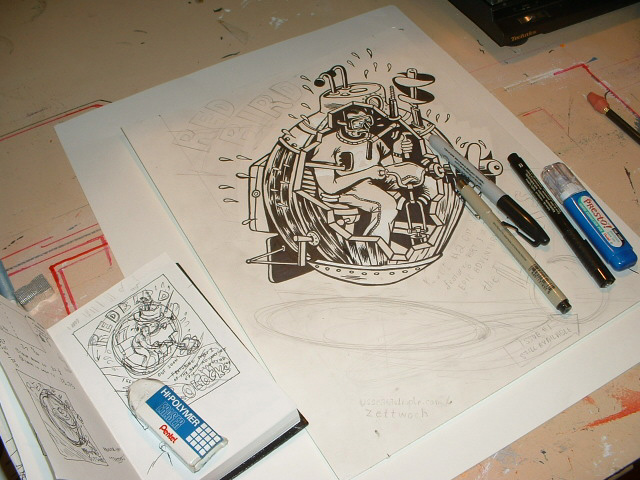HOW TO SILKSCREEN! |
1) THE SCREEN ITSELF:
this is the wooden (or in hi-tech cases, lightweight metal) frame. My dad
used to build these for me out of scrap wood, sometimes I've even used cheap
picture frames. As long as it's flat (i.e. it lays flat on the table), and
you can stretch silk on it, you can use it. Now, I build my own frames out
of 1"x1"s from Home Depot. This is definitely the cheapest way to do it
if you have access to a workshop, or at least a tablesaw. This is also nice
cuz you can build frames to any size or shape you want. Here's what it looks
like (FIG. A).
I buy the 'silk' (it's not really silk, it's a synthetic polyfiliament mesh)
by the yard. You can get it at nicer art stores or online (I use dickblick.com;
they have a pretty nice supply of all kinds of screenprinting supplies at
reasonable prices). I cut a piece a little larger than my screen size. Then
I fasten the silk to the frame. I do this buy cutting a 1/4" groove into
the 1x1's (again with the table saw), then use some thin rope to pinch and
tighten up the silk
You can also just use staples to hold the silk to the frame, sort of like
upholstery. Just make sure the silk is tight and even tightened across the
frame. The downside of this is that it's harder to remove the silk from
the frame later, if you need to. OKAY, having said all that, I would probably
recommend just buying a PRE-FAB frame+silk combo to start out. You can basically
just go into the art store and buy a readymade screen, in one of a few popular
sizes. This is pretty much the way to go for a starter, especially if you
don't have access to a workshop. Depending on the size (the bigger the prefab
screen, the more expensive), it will cost between $15 and $25 bucks. Keep
in mind that you can re-use this screen forever, but will probably only
be able to use the silk maybe 3 or 4 times tops. In order to be able to
re-use the screen, you'll need a bottle of chemicals called "Stencil Remover",
which will clean out the silk later. A bottle of this stuff probably cost
|
2) COATING/DRYING THE SCREEN: Before doing anything, you need to give your screen a quick rinsing/cleaning
with just some household dishsoap or liquid soap (FIG. D)
Okay, let that dry, and now you're ready to "goop" the screen with emulsion.
Emulsion is the green stuff that you will cover the screen in, and then
let dry overnight. Emulsion is a photo-sensitive goo made up of two components:
emulsion and sensitizer. When you buy it from the art store (or online)
it comes in two bottles, that you mix together right when you're ready to
coat the screen. When you add the sensitizer, it becomes light-sensitive,
so you'll want to work quickly and in low light. I use the Speedball brand
"Diazo" kit, which is inexpensive, easy to use, and lasts for a while. A
combo kit of this stuff (including both components) costs about $18. (FIG.
E)
Pour a bead of combined goop along one edge of the screen. You'll want to
use a stiff piece of cardboard, illustration board, or a squeegee to push
the goop across the screen. Keep doing it, flipping the screen back and
forth, coating both sides, until the whole screen is covered in a thin,
even coating of green goo
Don't admire your handiwork for too long, cuz you need to get that sucker
in your darkroom/drying chamber. You need to let this coated screen completely
dry in a completely dark place. If your screen is small enough, you can
use a drawer, or underneath a cardboard box. My screens are usually kind
of big though, so I use the only room I can completely seal off from light,
my bathroom (FIG. G)
As you can see in the pic, this also allows me to put a fan in there to
speed up the drying process (it'll take 3 hours rather than overnight).
It needs to be totally dark in there, so I cover the small shower window
with a towel and stuff a towel in the crack under the door. |
3) PREPARING YOUR ART While the screen is drying, this would be
a good time to finalize your artwork. I'd keep the artwork sort of chunky,
graphic and simple (no fine, feathered lines or crosshatching). If there's
text in there, I wouldn't go below 14 pt. (FIG. H)
Okay, once you've got your art all ready, you need to transfer it to clear
acetate. I do this by scanning my art (I do my color sep's in Adobe Illustrator
anyway, so my art is already in digital form) and just feeding a sheet (or
sheets) of acetate through my laserjet printer. Alternately, you could just
go to Kinko's and have them copy your art to acetate. Even if you're gonna
end up printing silver or orange ink or whatever, just have your art 'positive'
printed in BLACK. If your doing mutiple colors, you'll need to have separate
sheets of acetate (and eventually separate screens entirely), each of them
with a different black positive
|
4) EXPOSING THE SCREEN This is where you're gonna remove your coated, dry screen from the drying
chamber and 'burn' your artwork stencil on to it. It helps to understand
the science of this part. Even though the screen is dry, the green goop
on there is still malleable, and able to be rinsed out, if you were to put
it under your shower. That is, until light hardens it. Every photon that
hits the light-sensitive goo will harden it and make it water-proof, which
is basically what you're gonna do. Except your gonna put your sheet of acetate
between the light and screen, protecting the goop beneath the black areas
of your artwork. Here's what my light 'exposure station' looks like (FIG.
J)
The only real specialty item in this step is the 250w photoflood lightbulb,
which you can get from some hardware or art stores. You can definitely get
them from dickblick.com. The cost is only $4 or $5. It is important to have
that because it will only take 10 or 15 minutes to expose rather than an
hour and a half with a regular bulb. The black paper beneath the screen
helps absorb the stray light, and the glass holds your artwork flat to the
screen (to eradicate little shadows beneath your art). It's nice to have
that sheet of glass fit into the frame (smaller than the frame, but larger
than your artwork), but if you don't have it, you can just use little pieces
of clear tape to hold the acetate down. Okay, so what's happening here is
this: the focused cone of light is hardening all the goo on the screen,
except for the goo hidden beneath the opaque black areas of your artwork.
The Speedball emulsion kit comes with a little chart telling you how long
to expose your screen, and how high away from the screen the bulb should
be. |
5) RINSING THE SCREEN Okay, this is the fun part. This is also the part where you can really mess
it up! As soon as you've finished exposing the screen for the specified
amount of time, remove the glass and acetate and take your screen into the
bathroom, laundry sink, or outside to those garden hose. You're gonna need
a fairly powerful stream of water to rinse the still malleable goo (the
areas that had been hidden under your black artwork) out of the screen.
I have one of those 'massager attachments' on my shower and it's perfect
for this application. As you start moving the stream of water over the screen,
you'll see your image slowly start to emerge on the silk
As you rinse, occasionally hold your screen up to the light, to see how
well the goop is rinsing out. It's a delicate process; if you rinse for
too long, you'll start to obliterate areas you don't want too. If you don't
rinse long enough (or if you over-exposed your screen in step 4), the finer
areas of your artwork won't become fully stencilled and won't show up on
your prints. If some areas are particularly stubborn and won't rinse out,
you can use your finger or a soft brush to sort of gently massage or loosen
it up
This part can be tricky, so don't be discouraged if have to mess up and
do it over. Just use the stencil remover chemical to wash out all the emulsion,
let the screen dry, and start over tomorrow! |
|





































































